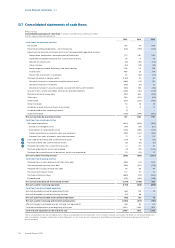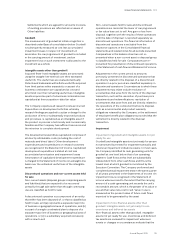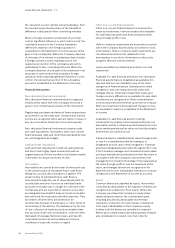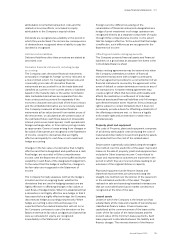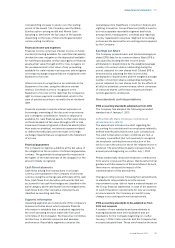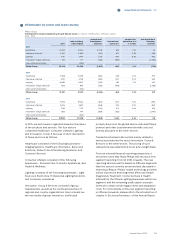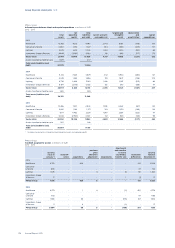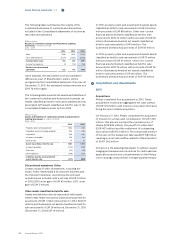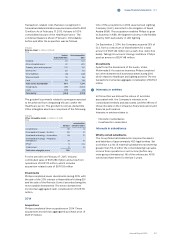Philips 2015 Annual Report Download - page 119
Download and view the complete annual report
Please find page 119 of the 2015 Philips annual report below. You can navigate through the pages in the report by either clicking on the pages listed below, or by using the keyword search tool below to find specific information within the annual report.Group nancial statements 12.9
Annual Report 2015 119
attributable incremental transaction costs and the
related income tax eects, is included in equity
attributable to the Company’s equity holders.
Dividends are recognized as a liability in the period in
which they are declared. The income tax consequences
of dividends are recognized when a liability to pay the
dividend is recognized.
Debt and other liabilities
Debt and liabilities other than provisions are stated at
amortized cost.
Derivative nancial instruments, including hedge
accounting
The Company uses derivative nancial instruments
principally to manage its foreign currency risks and, to
a more limited extent, for managing interest rate and
commodity price risks. All derivative nancial
instruments are accounted for at the trade date and
classied as current or non-current assets or liabilities
based on the maturity date or the earlier termination
date. Embedded derivatives are separated from the
host contract and accounted for separately if the
economic characteristics and risks of the host contract
and the embedded derivative are not closely related.
The Company measures all derivative nancial
instruments at fair value derived from market prices of
the instruments, or calculated as the present value of
the estimated future cash ows based on observable
interest yield curves, basis spread, credit spreads and
foreign exchange rates, or from option pricing models,
as appropriate. Gains or losses arising from changes in
fair value of derivatives are recognized in the Statement
of income, except for derivatives that are highly
eective and qualify for cash ow or net investment
hedge accounting.
Changes in the fair value of a derivative that is highly
eective and that is designated and qualies as a cash
ow hedge, are recorded in Other comprehensive
income, until the Statement of income is aected by the
variability in cash ows of the designated hedged item.
To the extent that the hedge is ineective, changes in
the fair value are recognized in the Statement of
income.
The Company formally assesses, both at the hedge’s
inception and on an ongoing basis, whether the
derivatives that are used in hedging transactions are
highly eective in osetting changes in fair values or
cash ows of hedged items. When it is established that
a derivative is not highly eective as a hedge or that it
has ceased to be a highly eective hedge, the Company
discontinues hedge accounting prospectively. When
hedge accounting is discontinued because it is
expected that a forecasted transaction will not occur,
the Company continues to carry the derivative on the
Balance sheet at its fair value, and gains and losses that
were accumulated in equity are recognized
immediately in the Statement of income.
Foreign currency dierences arising on the
retranslation of nancial instruments designated as a
hedge of a net investment in a foreign operation are
recognized directly as a separate component of equity
through Other comprehensive income, to the extent
that the hedge is eective. To the extent that the hedge
is ineective, such dierences are recognized in the
Statement of income.
Osetting and master netting agreements
The Company presents nancial assets and nancial
liabilities on a gross basis as separate line items in the
Consolidated balance sheet.
Master netting agreements may be entered into when
the Company undertakes a number of nancial
instrument transactions with a single counterparty.
Such an agreement provides for a net settlement of all
nancial instruments covered by the agreement in the
event of default or certain termination events on any of
the transactions. A master netting agreement may
create a right of oset that becomes enforceable and
aects the realization or settlement of individual
nancial assets and nancial liabilities only following a
specied termination event. However, if this contractual
right is subject to certain limitations then it does not
necessarily provide a basis for osetting unless both of
the osetting criteria are met, i.e. there is a legally
enforceable right and an intention to settle net or
simultaneously.
Property, plant and equipment
The costs of Property, plant and equipment comprises
of all directly attributable costs (including the cost of
material and direct labor). Government grants for assets
are deducted from the cost of the related asset.
Depreciation is generally calculated using the straight-
line method over the useful life of the asset. Gains and
losses on the sale of property, plant and equipment are
included in Other business income. Costs related to
repair and maintenance activities are expensed in the
period in which they are incurred unless leading to an
extension of the original lifetime or capacity.
Plant and equipment under nance leases and
leasehold improvements are amortized using the
straight-line method over the shorter of the lease term
or the estimated useful life of the asset. The gain
realized on sale and operating leaseback transactions
that are concluded based upon market conditions is
recognized at the time of the sale.
Leased assets
Leases in which the Company is the lessee and has
substantially all the risks and rewards of ownership are
classied as nance leases. Finance leases are
capitalized at the commencement of the lease at the
lower of the fair value of the leased assets and the
present value of the minimum lease payments. Each
lease payment is allocated between the liability and
nance charges. The interest element of the nance



